|
||||||
|
CARDUUS. Welted Thistles [Asteraceae] |
|
Twelve species of Carduus are recorded in Britain. These include the native Musk Thistle (C. nutans), Slender Thistle (C. tenuiflorus) and Welted Thistle (C. crispus). Fifteen British miners are recorded on Carduus. A key to the European miners recorded on Carduus is provided in Bladmineerders van Europa. |
Key for the identification of the known mines of British |
Note: Diptera larvae may live in a corridor mine, a corridor-blotch mine, or a blotch mine, but never in a case, a rolled or folded leaf, a tentiform mine or sandwiched between two more or less circular leaf sections in later instars. Pupation never in a cocoon. All mining Diptera larvae are leg-less maggots without a head capsule (see examples). They never have thoracic or abdominal legs. They do not have chewing mouthparts, although they do have a characteristic cephalo-pharyngeal skeleton (see examples), usually visible internally through the body wall. The larvae lie on their sides within the mine and use their pick-like mouthparts to feed on plant tissue. In some corridor miners frass may lie in two rows on alternate sides of the mine. In order to vacate the mine the fully grown larva cuts an exit slit, which is usually semi-circular (see Liriomyza huidobrensis video). The pupa is formed within the hardened last larval skin or puparium and as a result sheaths enclosing head appendages, wings and legs are not visible externally (see examples). See Key to non-Diptera. |
1a > Leaf-miner: Long narrow interparenchymal mine, greenish. Pupation in leaf at end of mine (Spencer, 1976: 503 (fig. 880)). Unusually long, interparenchymatous, therefore yellowish corridor that remains of equal width throughout its length. (In some plants with thin leaves, like Cirsium oleraceum the mines are not interparechymatous but either full-depth or alternating upper- and lower-surface). The mine makes few curves, and hardly any u-turn, causing the mine to usually occupy the entire length of a leaf. Frass in two rows of grains along the sides. Pupation within the mine, in a lower-surface puparial chamber; the anterior spiracles penetrate the epidermis. |
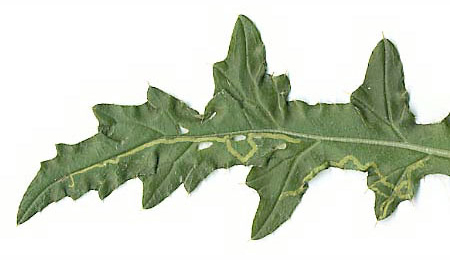 Mines of Phytomyza spinaciae on Cirsium arvense Image: © Willem Ellis (Bladmineerders van Europa) |
|
Phytomyza spinaciae Hendel, 1928 [Diptera: Agromyzidae]. |
1b > Leaf-miner: Larva feeds along the mid-rib, predominantly on the lower surface and there is little evidence of gall-like swelling. Pupation takes place at the base of the midrib (Spencer, 1976: 496). |
|
Phytomyza continua Hendel, 1920 [Diptera: Agromyzidae]. |
1c > Leaf-miner: Mine linear, whitish, both upper and lower surface. Pupation internal, at the end of the mine with the anterior spiracles projecting through the epidermis (Spencer, 1976: 433). Upper-surface, less often lower-surface corridor. Frass in isolated grains. Pupation within the mine, usually in a lower-surface puparial chamber. A long whitish upper surface corridor, which eventually goes lower surface. |
|
Chromatomyia syngenesiae Hardy, 1849 [Diptera: Agromyzidae]. |
1d > Leaf-miner: Large, very transparent blotch, with primary and secundary feeding lines. In the centre a concentration of black frass. Mines can coalesce, and then contain several larvae. At the start of the mine, at the leaf underside, a white egg shell. However, the larva can leave its mine and restart elsewehere, therefore mines without an egg shell may occur as well. A white egg is laid at the start of the mine, on the leaf underside. A large clear mine is formed in the centre of the leaf, with a black frass pile. Mines may coalesce and so a mine may contain several larvae (British Leafminers). |
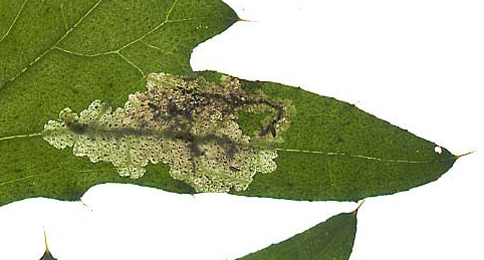 Mine of Pegomya steini on Cirsium vulgare Image: © Willem Ellis (Bladmineerders van Europa) |
|
Pegomya steini Hendel, 1925 [Diptera: Anthomyiidae]. |
1b > Leaf-miner: A distinctive mine primarily above mid-rib, with irregular short lateral offshoots into leaf blade. Pupation external (Spencer, 1972: 51 (fig. 172), 55; Spencer, 1976: 270, 271 (fig. 486)). Branched, whitish, upper-surface corridor; main axis overlying the midrib; side branches overlying the main lateral veins. (In Campanula and Phyteuma the mine is much less branched, sometimes nothing more than a corridor on top of the midrib). Frass in rather long strings. Usually the mines begins as a long and narrow, shallow, tortuous lower-surface corridor that ends upon the midrib but otherwise is not associated with the leaf venation. Often this initial corridor is filled with callus, and then even less conspicuous. Pupation outside the mine. A linear mine on the upper surface, usually following the midrib and showing side branches along the veins. The frass is in strings. |
|
Liriomyza strigata (Meigen, 1830) [Diptera: Agromyzidae]. |
1c > Leaf-miner: Full depth, initially a much branched corridor, irregular in width, in the end almost a blotch. The mine has openings by which part of the frass is ejected. The larvae frequently leave the mine to restart elsewhere. Older larva live free and cause window feeding, often erasing their old mines. In Coltsfoot also pseudo-mines are made, when the larva eats away the lower epidermis with the leaf tissue, but spares the dense hair cover. |
|
Phytosciara halterata Lengersdorf, 1926 [Diptera: Sciaridae]. |
| 1d > Leaf-miner: A
shallow, upper surface, whitish linear mine. Pupation external (Spencer, 1972b: 72 (fig. 233A), 77).
Tortuous, upper-surface corridor, often somewhat geryish, and/or following the leaf margin. Frass grains fairly small, separated by about their own diameter. Primary feeding lines often conspicuous. Pupation outside the mine; exit slit in upper epidermis. A long whitish upper surface mine. The frass grains are small and can occur close together. |
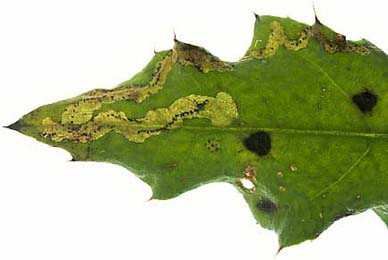 Mine of Phytomyza cirsii on Cirsium arvense Image: © Willem Ellis (Bladmineerders van Europa) |
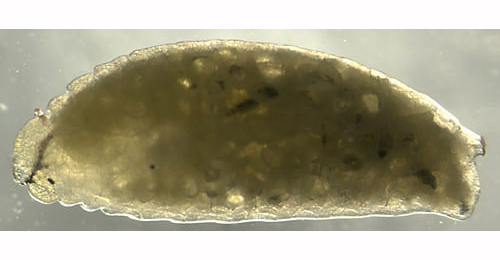 Phytomyza cirsii larva, lateral Image: © Willem Ellis (Bladmineerders van Europa) |
|
Phytomyza cirsii Hendel, 1923 [Diptera: Agromyzidae]. |
|
Key for the identification of the known mines of British |
Note: The larvae of mining Coleoptera, Hymenoptera and Lepidoptera may live in a corridor mine, a corridor-blotch mine, a blotch mine, a case, a rolled or folded leaf, a tentiform mine or sandwiched between two more or less circular leaf sections in later instars. Larva may pupate in a silk cocoon. The larva may have six legs (although they may be reduced or absent), a head capsule and chewing mouthparts with opposable mandibles (see video of a gracillarid larva feeding). Larvae of Hymenoptera and Lepidoptera usually also have abdominal legs (see examples). Frass, if present, never in two rows. Unless feeding externally from within a case the larva usually vacates the mine by chewing an exit hole. Pupa with visible head appendages, wings and legs which lie in sheaths (see examples). |
1a > Leaf-miner and case-bearer: The larva lives outside the mine, protected by a case, and feeds on the underlying plant tissues via a hole cut in the epidermis. From that point it eats away as much leaf tissue as it can reach without fully entering the mine. Mine does not contain frass (Coleophora species) |
1b > Leaf-miner, but not a case-bearer: The larva lives mainly inside the mine. Mine usually contains frass. In later instars the larva may live sandwiched between two more or less circular sections cut from the leaf. |
2a > Leaf-miner and case-bearer: Larva mines leaves. On Eupatorium the case is extended at the anal end by adding silk and widened by cutting a ventral gusset. On Inula the case is firstly extended by adding rings of leaf-cuticle at the oral end, before reverting to the method used when on Eupatorium. The full-grown case is 10 mm long. A slender tubular silken case, about 10 mm long, straw coloured, three valved. Mouth angle about 30°. |
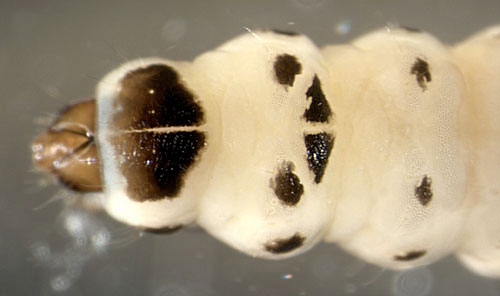 Coleophora folicularis larva, dorsal Image: © Willem Ellis (Bladmineerders van Europa) |
| On Cirsium, Eupatorium, Inula and Pulicaria, but not yet on Carduus, in Britain and Achillea, Anthemis, Carduus, Cirsium, Eupatorium, Inula, Leucanthemum, Pulicaria and Tanacetum elsewhere. Widespread in England. Also recorded in Republic of Ireland. Widespread in continental Europe. |
Coleophora follicularis (Vallot, 1802) [Lepidoptera: Coleophoridae]. |
2b > Leaf-miner and case-bearer: Larva mines leaves. The larva builds a case from silk, resembling a razor shell in appearance.. The full-grown case is 12 mm long and blackish-brown. The full grown larva lives in a blackish brown trivalved tubular silken case of about 8 mm. The mouth angle is 0°-10°, causing the case to lay almost flat on the leaf. |
|
Coleophora paripennella Zeller, 1839 [Lepidoptera: Coleophoridae]. |
2c > Leaf-miner and case-bearer: The larva forms a case, approximately 11-12 mm long, beneath a thistle leaf, although burdock may sometimes be used. The shape of the ochreous case varies as, when being enlarged, it is elongated first, and the girth increased subsequently. Yellow-brown to light grey tubular silken case with darker length lines. The case is fairly large (up to 17 mm) and very slender. The rear end is three-valved, the mouth angle about 50°. The larva feeds at the underside of the leaf. |
|
Coleophora peribenanderi Toll, 1943 Lepidoptera: Coleophoridae]. |
3a > Leaf-miner: The eggs of this species are laid on a leaf, with the larvae mining the underside of the leaf, until a late instar when it feeds in a web under the midrib of the leaf, causing visible blotching on the upperside. Short, full depth corridor. The larva relatively long lives as a miner, but finally leaves the mine and continues living in spinning along the midrib at the leaf underside, from where windows are eaten in the leaf. |
 Mines of Agonopterix propinquella on Cirsium arvense Image: © Ian Smith (UKMoths) |
|
Agonopterix propinquella (Treitschke, 1835) [Lepidoptera: Depressariidae]. |
3b > Leaf-miner: Rather long full depth corridor that winds freely through the leaf and may cross itself. In the end the corridor widens considerably. Frass mostly in a narrow central line, but may also be deposited along the sides or be missing. The larvae regular leave a mine to restart elsewhere. Pupation outside the mine. Neither larva or mine can be distinguished from that of related species. |
|
Apteropeda orbiculata (Marsham, 1802) [Coleoptera: Chrysomelidae]. |
3c > Leaf-miner: Rather narrow corridor, untidy and sometimes branched, starting from the base of the leaf, in particular the midrib. Sides of the corridor irregularly eaten out, not really parallel. Frass mostly present, and then in a central line. The larva is capable of leaving the mine and start a new one elsewhere. These later mines are much broader, and the frass is scattered irregularly.. |
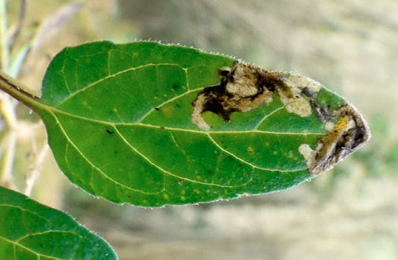 Mine of Orthochaetes insignis on Prunella vulgaris Image: © Jean-Yves Baugnée (Bladmineerders van Europa) |
|
Orthochaetes insignis (Aube, 1863) [Coleoptera: Curculionidae]. |
|
3d > Leaf-miner: The mine is brownish and extends along the midrib, sometimes branching. Oviposition on top of the midrib. Immediately after emergence the larva gnaws a cavity in the midrib, and from there an irregular blotch is made adjacent to the midrib. The larva continues living in the midrib that is gradully hollowed out, making from there broad, brownish, full depth excursions in the blade. The mine contains much frass; most of it is concentrated in the area immediately bordering the midrib. Older, no longer occupied parts of the mine often split open. Mines mainly on the lower leaves. The slender larvae move surprisingly fast upon disturbance; when they rest (in daytime) they lie lengthwise in the hollowed midrib. Pupation outside the mine. |
|
Scrobipalpa acuminatella (Sircom, 1850) [Lepidoptera: Incurvariidae]. |
3e > Long corridor, often following the leaf margin, with little frass and with the sides irrregularly eaten out. The first part of the corridor is full depth and makes a few close loops; the later part is more upper-surface and rather wide. Primary feeding lines often conspicuous. No morphological differences are known between the larva of S. rubidum and S. testaceum (Steinhausen, 1994a). However, there is a phenological difference: the larva of testaceum hibernates in the mine and continues feeding after winter; S. rubidum vacates the mine before winter and pupates in the soil. Hering (1957a) suggests that the identification of the beetles is an easy matter, but that is contradicted by Warchalowski (2003a).. |
|
Sphaeroderma testaceum (Fabricius, 1775) [Coloeptera : Chrysomelidae]. |
3f > Long corridor mine, without obvious relation with the leaf margin, with little frass and irregularly eaten out sides. The first part of the mine is full depth and makes a few close loops; the second part is upper-surface and considerably wider. Primary feedings lines often obvious. The larva is so broad that is completely fills the mine. No morphological differences are known between the larvae of S. rubidum and those of S. testaceum (Steinhausen, 1994a). The larva leaves the mine to pupate in the soil (the larva of testaceum hibernates in the mine.) Hering (1957a) suggests that the imagines are easily separated, but this is contradicted by Warchalowski (2003a).. |
|
Sphaeroderma rubidum (Graells, 1858) [Coloeptera : Chrysomelidae]. |
| Last updated 01-Jul-2019 Brian Pitkin | ||
